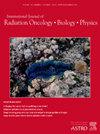Tumor Treating Fields (TTFields) after Stereotactic Radiosurgery (SRS) for Brain Metastases from Non-Small Cell Lung Cancer (NSCLC BM): Final Results of The Phase 3 METIS Trial
IF 6.5
1区 医学
Q1 ONCOLOGY
International Journal of Radiation Oncology Biology Physics
Pub Date : 2025-10-14
DOI:10.1016/j.ijrobp.2025.08.027
引用次数: 0
Abstract
Purpose/Objective(s)
Local therapy for NSCLC BM includes resection, SRS and whole brain radiotherapy (WBRT). Intracranial progression after resection or SRS is more frequent than with WBRT, but WBRT causes more neurotoxicity and neurocognitive decline. Delaying intracranial failure while preserving neurocognition is an unmet need. TTFields, electric fields delivered via scalp-placed arrays that disrupt cancer cell division, have demonstrated efficacy in glioblastoma, NSCLC and pancreatic cancer.
Materials/Methods
In the METIS trial (NCT02831959), adults with 1–10 newly diagnosed NSCLC BM suitable for SRS and receiving optimal therapy for extracranial disease were eligible. Prior WBRT, presence of known druggable mutations, single operable or recurrent BM were exclusion criteria. Patients (pts) were randomized 1:1 to SRS followed by TTFields therapy (150 kHz) or SRS alone. A blinded independent radiology review committee assessed radiographic progression. The primary endpoint of time to intracranial progression (TTIP, RANO-BM) was analyzed using cumulative incidence competing risk and Fine-Gray test to determine a difference. Secondary endpoints included time to distant progression (TTDP), neurocognitive function, overall survival (OS), quality of life (QoL) and safety.
Results
The trial enrolled 298 pts (TTFields after SRS vs SRS): median age 63 vs 64 years; KPS ≥80 81% vs 91%; median time from NSCLC diagnosis 1.5 vs 2.2 months; adenocarcinoma 75% vs 79%. Median duration of TTFields therapy was 15.7 (0.1–193.1) weeks; median monthly usage was 67.1% (0.8–96.7%). Time to first intracranial progression from SRS was significantly delayed with TTFields therapy (HR 0.72, 95% CI 0.53–0.98; p=0.044). Intracranial progression rates at months 2, 6, 12, and 24 were 13.6% vs 22.1% (p=0.034), 33.7% vs 46.4% (p=0.018), 46.9% vs 59.4% (p=0.023), and 53.6% vs 65.2% (p=0.031; post hoc). In the 118 pts receiving immune checkpoint inhibitors (ICI) for their primary disease, TTIP benefit was more pronounced (HR 0.63, 95% CI 0.39–1.0; Cox p=0.049; Fine-Gray test p=0.055; post-hoc). While no difference in TTDP was observed overall (HR 0.76, 95% CI 0.51-1.12, p=0.165; post-hoc), in pts receiving ICI, TTFields therapy delayed TTDP compared with SRS alone (HR 0.41, 95% CI 0.21–0.81; p=0.009; post-hoc). Time to neurocognitive failure, OS and radiological response rate did not differ significantly. Device-related AEs were mainly grade ≤2 skin events. TTFields did not cause QoL deterioration, and improvements in deterioration-free survival and time to deterioration of global health status, physical functioning and fatigue were observed (post-hoc).
Conclusion
By significantly prolonging time to intracranial progression, without deteriorating QoL or cognitive function, TTFields therapy after SRS is a potential new treatment option for pts with NSCLC BM. .
立体定向放射手术(SRS)治疗非小细胞肺癌(NSCLC)脑转移瘤后的肿瘤治疗场(TTFields): 3期METIS试验的最终结果
目的:NSCLC脑转移的局部治疗包括切除、SRS和全脑放疗(WBRT)。切除术或SRS后颅内进展比WBRT更频繁,但WBRT引起更多的神经毒性和神经认知能力下降。延迟颅内衰竭,同时保留神经认知是一个未满足的需求。TTFields是一种通过放置在头皮上的电场阵列来破坏癌细胞分裂的电场,已经证明对胶质母细胞瘤、非小细胞肺癌和胰腺癌有效。材料/方法在METIS试验(NCT02831959)中,1-10例新诊断的NSCLC BM适合SRS并接受最佳颅外疾病治疗的成人符合条件。既往WBRT,存在已知的可药物突变,单一可手术或复发的BM是排除标准。患者(pts)以1:1的比例随机分配到SRS组,然后进行TTFields治疗(150 kHz)或单独SRS。一个独立的盲法放射学审查委员会评估了放射学进展。主要终点颅内进展时间(TTIP, RANO-BM)采用累积发生率竞争风险和Fine-Gray检验来分析差异。次要终点包括到远处进展时间(TTDP)、神经认知功能、总生存期(OS)、生活质量(QoL)和安全性。结果该试验纳入298例患者(SRS vs SRS后的TTFields):中位年龄63 vs 64岁;KPS≥80 81% vs 91%;NSCLC诊断的中位时间为1.5个月vs 2.2个月;腺癌75% vs 79%。TTFields治疗的中位持续时间为15.7(0.1-193.1)周;月使用率中位数为67.1%(0.8-96.7%)。TTFields治疗显著延迟了SRS到首次颅内进展的时间(HR 0.72, 95% CI 0.53-0.98; p=0.044)。颅内进展率在第2、6、12和24个月分别为13.6% vs 22.1% (p=0.034)、33.7% vs 46.4% (p=0.018)、46.9% vs 59.4% (p=0.023)和53.6% vs 65.2% (p=0.031)。在118名接受免疫检查点抑制剂(ICI)治疗原发疾病的患者中,TTIP的益处更为明显(HR 0.63, 95% CI 0.39-1.0; Cox p=0.049;细灰色试验p=0.055; post-hoc)。虽然TTDP总体上没有差异(HR 0.76, 95% CI 0.51-1.12, p=0.165;事后),但在接受ICI的患者中,与单独使用SRS相比,TTFields治疗延迟了TTDP (HR 0.41, 95% CI 0.21-0.81; p=0.009;事后)。到神经认知功能衰竭的时间、OS和放射学反应率无显著差异。器械相关ae主要为≤2级皮肤事件。TTFields没有导致生活质量恶化,并且观察到无恶化生存期和总体健康状况、身体功能和疲劳恶化时间的改善(事后)。结论TTFields治疗可显著延长患者颅内进展时间,且不影响患者的生活质量和认知功能,是治疗非小细胞肺癌脑转移患者的新选择。
本文章由计算机程序翻译,如有差异,请以英文原文为准。
求助全文
约1分钟内获得全文
求助全文
来源期刊
CiteScore
11.00
自引率
7.10%
发文量
2538
审稿时长
6.6 weeks
期刊介绍:
International Journal of Radiation Oncology • Biology • Physics (IJROBP), known in the field as the Red Journal, publishes original laboratory and clinical investigations related to radiation oncology, radiation biology, medical physics, and both education and health policy as it relates to the field.
This journal has a particular interest in original contributions of the following types: prospective clinical trials, outcomes research, and large database interrogation. In addition, it seeks reports of high-impact innovations in single or combined modality treatment, tumor sensitization, normal tissue protection (including both precision avoidance and pharmacologic means), brachytherapy, particle irradiation, and cancer imaging. Technical advances related to dosimetry and conformal radiation treatment planning are of interest, as are basic science studies investigating tumor physiology and the molecular biology underlying cancer and normal tissue radiation response.

 求助内容:
求助内容: 应助结果提醒方式:
应助结果提醒方式:


